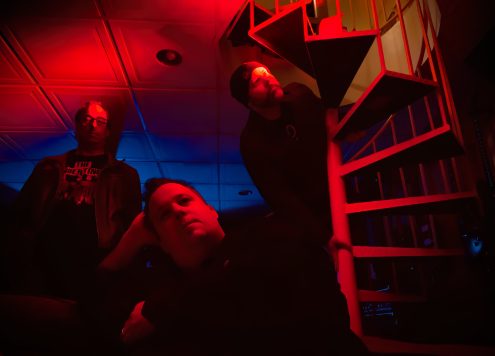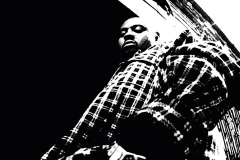Establishing a musical brand they call midwestern high lonesome music, the Cleveland ensemble Orefice Roth has created a profoundly moving environment with their debut single “LET ME IN, LET ME IN, LET ME IN.” The blooming acoustic guitar strumming start of the track delicately unites the dreamy synths and pedal steel. The combination of folk and experimental rock also demonstrates the pained vocals courtesy of vocalist/guitarist Skylar Keffer. “I wrote this song about a dark place, in both structure and frequency. It’s about creating a space inside of it and radiating light despite it,” Keffer says regarding “LET ME IN, LET ME IN, LET ME IN.” It’s about where I used to live with my family. When we left it, and when it was scrubbed of any trace of us, not a dish, not a receipt, not a hair and not a skin cell, we stepped back and witnessed darkness reclaim the empty space like vines on ruins. I would ritualistically drive past it and get this feeling in my stomach. I expected it to see it with its windows smashed and its door kicked in, or maybe it just wouldn’t be there anymore. I felt protective and scared. This is the context this song exists in and where it came from.”
The production on this track stands out right away, a mix of folk guitars, dreamy reverb, full room sounds. Since this is the debut single for Orefice Roth, what was the motivation and intent when you first went into the studio with this?
To sneak up on ourselves and catch the group red-handed. To catch us in the act of conjuring as if listening devices weren’t towering over our heads listening to every word, every note.
On a production level, the intent was to focus on creating a palette of sounds that tonally resonated with the mood that was struck when the lyrical content was married to the chord progression. The images it projected onto the backside of my eyelids when I closed my eyes and the posture it put my body in.
And separating ourselves more from the mixing process by having it mixed by Nick Kinsey up at Chicken Shack was both creatively the right move as far as avoiding fatigue and also a big step towards achieving the sound we want, which he delivered on in spades.
Was this the first song you recorded for your upcoming EP? What else can we look forward to on that upcoming project?
“Let me in” is actually a stand-alone single. We do have an EP that is currently in the mixing stage, but it is from a much larger collection of songs that “Let me in” was never a part of. “Let me in” came to us in a totally different way. Usually, I bring songs to the band much more flushed out, and the band functions more like a “songwriting outfit,” but let me in came from an improvisation at our rehearsal space. We just played the right things at the right time one night, and we all just felt it click. What you hear on the recording is really just a second by second/measure by measure recreation of a blown-out phone recording taken from that rehearsal. It just came out fully formed. That’s what I meant about the recording process being “to catch ourselves conjuring” because it really didn’t feel like songwriting. It felt like we conjured. We hope to release the EP in late summer.
How do you feel Ohio influences your music? There’s a nostalgia to the lyrics that sounds relatable to anyone from the heartland of the country.
Mostly indirectly. I can’t say that the region I’m from is something at the front of my mind while I’m writing, but of course Ohio is there the whole time. It’s had a lot to do with forming my view, what’s around me, and my relationship to it for better or worse. The nostalgic feeling that people might exhume from these lyrics probably has less to do with the literal house that I’m referring to and maybe more to do with wanting to “go back” in general. Why do we want to go back to broken things? Things and places that are missing integral parts and pose a threat. I can certainly say that the weather in Ohio absolutely destroys a lot of people I know and exacerbates depression/anxiety and substance abuse, so maybe to a large population, going back to a broken place is the best they think they can achieve. It’s what we think we deserve. Going back to a broken place also gives you a second chance at fixing things. You can’t move forward to bigger and better things if you still feel you have work to do.
Mike Brenner plays some amazing pedal steel on this track that really ties it together. He’s played with bands like Wild Pink. How did you two hook up?
Besides what this song means to me as far as what it’s about, on a different kind of personal level, it was about giving myself permission. I hold myself back and withhold things from myself out of debilitating anxiety and a general feeling that I’m not good enough. The parallel personal story behind the making of this song is breaking through and debunking my negative self-talk. I’ve appreciated Mike’s work for years through his contributions to Jason Molina’s recordings in Songs: Ohia and Magnolia Electric co. More recently, I noticed him working with artists like Wild Pink and Max Stern of Signals Midwest and that started me thinking that even though he has no clue who I am, if I put my best work forward, maybe he would be willing to play on it. So that, coupled with the fact that the pandemic had created a bigger need for remotely collaborating with artists, I talked myself into giving myself the permission to simply reach out and ask. The worst thing that could happen is he simply says “no.” Luckily he was into the song and was an absolute joy to work with. When I pitched the idea to the band, they were excited but couldn’t really imagine what he was going to add to the song, and now none of us can imagine the song without his playing.
I’m looking forward to continuing my working relationship with Mike and There’s a good chance you’ll hear him pop up on some of the cuts off the coming EP.












Social Media